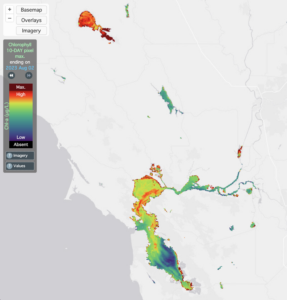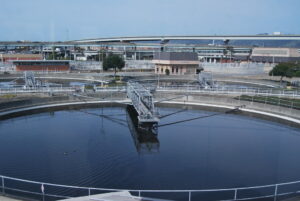If you look down at street drains at certain spots in Berkeley, you’ll notice stenciled onto the curb words to the effect of “Do Not Dump. Drains to Bay.” Of course, virtually everything around here (except the Pacific-facing slope of the outer coast range) “drains to Bay.” In fact, 40% of the land surface of California “drains to Bay.” That means most everything we do here has an impact on this “imenso brazo del mar”—immense arm of the sea—that so impressed the men of the Portolá expedition when they first saw it from atop Sweeney Ridge in 1769.
This Bay, this vast opening to the sky ringed by densely inhabited urban areas, is actually something of an accident, geologically speaking. Were it not for the fairly proximate gaps in the inner and outer coast ranges (at Carquinez Strait and the Golden Gate), this would have been a large and pleasant valley, a bigger version of the Salinas Valley to the south, great for agriculture, but certainly not the site of a major metropolis, nor the largest estuary on the west coast of the Americas.
But as it is, the Bay receives water from mountain ranges stretching from Mount Shasta in the north, down along the Sierra to the Tehachapis south of Bakersfield. At the Golden Gate, all that water flows out into the Pacific Ocean…except when the tide turns, and the salt water comes flooding back into the Bay and up into the Delta.
Following all this water into the former valley came enormous numbers of living things, from dense schools of salmon to immense flocks of shorebirds and waterfowl, thick rafts of sea otters, and, yes, human beings. The Bay is why we are all here. The biological richness and complexity of this body of water is only dimly understood by those of us who live here now, as we no longer depend on it for our survival. But the importance of the Bay as a vibrant and integrated system was intuited in the daily practice of the Native American peoples who led relatively stable lives around it for several thousand years. It is a testament to the depth and resiliency of this system that even after two centuries of filling and channeling and diking and paving and dumping and bridging by the settlers who displaced the native Ohlone and Miwok, the Bay remains a rich and vital body of water.
With the blocking of plans to extend San Francisco International Airport another 11,000 feet out into the Bay, and the recent purchase of 16,500 acres of bayside salt ponds from Cargill by the state, it seems we may have turned a corner and stand now on the verge of an unprecedented project to “undevelop” the Bay. In the special report in this issue, funded by the Bay Fund Initiative of the San Francisco Foundation, we look at the most significant human-generated factors currently impacting the health of San Francisco Bay, with the goal of gaining a deeper understanding of how this inland sea works, and how we might become better stewards dedicated to nursing it back to health.
Take a moment to imagine what it would be like to live in a Bay Area that had risen to the challenge and undertaken the largest collaborative restoration project in U.S. history. Where we would live next to a Bay almost as wild as the most remote wilderness, and yet as thoroughly familiar and accessible as a neighborhood park, a welcoming home for all creatures, from mysid shrimp to shiner perch to Caspian terns to sea otters to leopard sharks to humans. It’s our Bay to embrace and make whole again…if we decide to do it.




